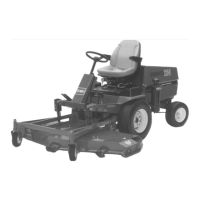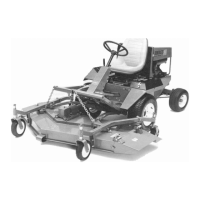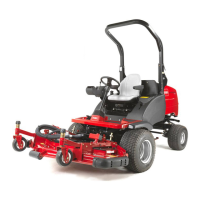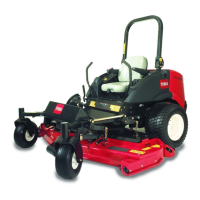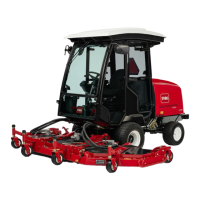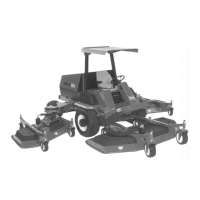17
The cooling system is filled with a 50/50 solution of water
and permanent ethylene glycol anti-freeze. Check level of
coolant at beginning of each day before starting the engine.
Capacity of cooling system is approximately 6 quarts (5.7
l).
1. Carefully remove radiator cap and the expansion tank
cap (Fig. 14).
• If engine has been running, pressurized hot
coolant can escape when radiator cap is
removed and cause burns.
Caution
1
2
3
Figure 14
1. Radiator cap
2. Expansion tank cap
3. Expansion tank fill marks
2. Check level of coolant in radiator. Radiator should be
filled to the top of the filler neck and the expansion tank
filled to between the marks on its side.
3. If coolant level is low, replenish the system. DO NOT
OVERFILL.
4. Install radiator cap and expansion tank cap.
Check Hydraulic System Fluid
The axle housing acts as the reservoir for the system. The
transmission and axle housing are shipped from the factory
with approximately 5 quarts (4.7 l) of high quality
hydraulic fluid. Check the level of hydraulic fluid before
the engine is first started and daily thereafter.
Appropriate hydraulic fluids are listed below.
The following list is not assumed to be all–inclusive.
Hydraulic fluids produced by other manufacturers may be
used if they can cross reference to find an equivalent to the
products listed. Toro will not assume responsibility for
damage caused by improper substitutions, so use only
products from reputable manufacturers who will stand
behind their recommendation.
Universal Tractor Hydraulic Fluid
Mobil Mobil Fluid 424
Amoco 1000 Fluid
Chevron Tractor Hydraulic Fluid
Conoco Power-Tran 3
Exxon Torque Fluid
Pennzoil Hydra–Tranz
Shell Donax TD
Texaco TDH
Note: Many hydraulic fluids are almost colorless, making it
difficult to spot leaks. A red dye additive for the hydraulic
system oil is available in 2/3 oz. (20 ml) bottles. One bottle
is sufficient for 4–6 gal (15–22 1) of hydraulic oil. Order
part no.44–2500 from your authorized Toro distributor.
1. Position machine on a level surface. Place all control in
neutral position and start the engine. Run engine at
lowest possible RPM to purge the system of air. DO
NOT ENGAGE PTO. Cycle steering wheel several
times fully to the left and right. Raise the cutting unit to
extend lift cylinders, aiming steering wheels straight
forward and stop the engine.
2. Remove dipstick cap (Fig. 15) from filler neck and wipe
it with a clean rag. Screw dipstick cap finger-tight onto
filler neck; then remove it and check level of fluid. If
level is not within 1/2 inch (13 mm) from the groove in
the dipstick (Fig. 15), add enough high quality
hydraulic fluid to raise level to groove mark. Do not
overfill.
1
Figure 15
1. Hydraulic system reservoir fluid/add dipstick cap
3. Thread dipstick fill cap finger-tight onto filler neck. It is
not recommended to tighten cap with a wrench.
4. Check all hoses and fittings for leaks.

